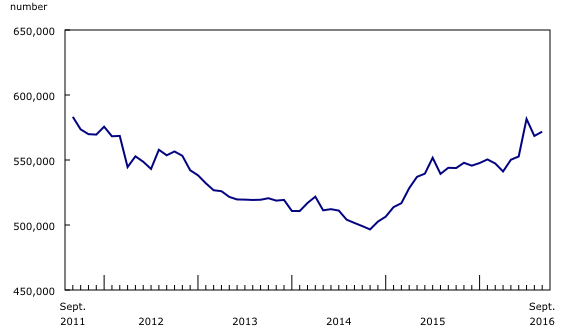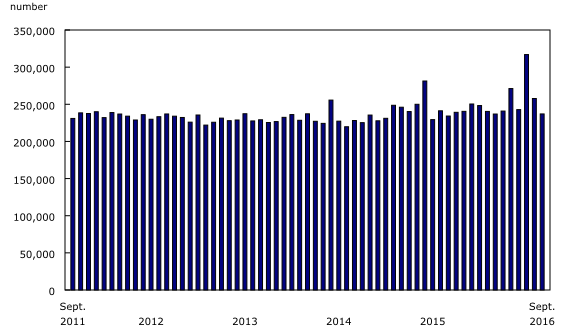Employment Insurance, September 2016
Archived Content
Information identified as archived is provided for reference, research or recordkeeping purposes. It is not subject to the Government of Canada Web Standards and has not been altered or updated since it was archived. Please "contact us" to request a format other than those available.
Released: 2016-11-22
Regular Employment Insurance (EI) beneficiaries totalled 571,800 in September, up slightly from August (+3,300 or +0.6%). On a year-over-year basis, the number of beneficiaries was up 27,800 (+5.1%).
Legislative changes to the EI program came into effect in July 2016. While some of these changes affected all EI regions across Canada, eligible claimants in the 15 regions that posted notable increases in unemployment received additional weeks of regular benefits starting in July. More information on the 2016 EI changes is available on Employment and Social Development Canada's (ESDC) website. EI regions are geographic entities whose boundaries are determined by ESDC for the purpose of administering the EI program. More information on these EI regions is available on the ESDC website.
Sub-provincial overview
As a result of the changes to the EI program, historical comparisons are not recommended, except in areas outside of the 15 EI regions where eligible claimants received additional weeks of benefits. These 15 EI regions are Newfoundland and Labrador, Northern Ontario, Sudbury, Northern Manitoba, Southern Saskatchewan, Northern Saskatchewan, Saskatoon, Southern Alberta, Northern Alberta, Calgary, Edmonton, Southern Interior British Columbia, Northern British Columbia, Whitehorse and Nunavut.
The analysis of data on regular EI beneficiaries for the month of September—as was the case for the months of July and August—is therefore focused on the census metropolitan areas (CMAs) outside of these 15 EI regions.
In Halifax, Nova Scotia, the number of beneficiaries fell by 1.1% to 5,300 in September, partly offsetting an increase in August.
The number of EI recipients in Moncton, New Brunswick, rose by 1.3% from the previous month to 3,200, while there was little change in Saint John.
At the same time, in Quebec, the number of beneficiaries fell in Saguenay (-3.5%) and in Trois-Rivières (-2.2%), while it was little changed in the other CMAs.
In Ontario, most CMAs—excluding those affected by the legislative changes—had more people receiving benefits in September. Notable increases were observed in Barrie (+4.3%) and Hamilton (+3.0%). On the other hand, there were declines in London (-7.5%), Windsor (-3.7%) and Oshawa (-1.2%). There was virtually no change in Toronto and St. Catharines–Niagara.
In September, the number of EI recipients in Winnipeg, Manitoba, was down 1.2% to 7,700.
The number of beneficiaries in Regina, Saskatchewan, rose by 6.8% to 2,400 in September, following a similar increase in August.
Compared with August, the number of people receiving EI benefits in British Columbia decreased in all three CMAs that were unaffected by the EI program changes: Vancouver (-3.2%), Victoria (-3.2%) and Abbotsford–Mission (-2.4%).
Regular Employment Insurance beneficiaries by occupation
With the current release of September data, analysis of EI beneficiaries by occupation will resume, as the data have been updated to the 2011 National Occupational Classification. However, given the legislative changes that came into effect in July, historical comparisons of occupation data are not recommended for recent months.
Looking at the occupation distribution of EI beneficiaries, the number of those whose last job was in trades, transport and equipment operators was 200,700 in September. This occupational group had the largest number of beneficiaries, followed by sales and services (86,300) and business, finance, and administrative occupations (62,900). Together, these three groups represented 61% of the total number of EI beneficiaries. At the same time, according to the Labour Force Survey (LFS), these three groups accounted for 55% of total employment (CANSIM table 282-0155).
On the other hand, health (8,100) and arts, culture, recreation and sport (8,900) had the lowest number of EI beneficiaries among all of the major occupational groups. These two groups represented 3% of the total number of beneficiaries, while they accounted for 10% of total employment according to the LFS.
Employment Insurance claims
The number of EI claims totalled 237,000 in September, down 8.0% from the previous month. Compared with 12 months earlier, EI claims were up 1.2% at the national level. Given the legislative changes that came into effect in July, historical comparisons of claims are not recommended.
Note to readers
Availability of data by occupation
With the current release of September data, information on Employment Insurance (EI) beneficiaries by occupation, based on the 2011 National Occupational Classification, is available in CANSIM tables 276-0042 and 276-0043.
Concepts and methodology
EI statistics are produced from administrative data sources provided by Service Canada and Employment and Social Development Canada. These statistics may, from time to time, be affected by changes to the Employment Insurance Act or administrative procedures, as has been the case since July 2016, when legislative changes to the EI program came into effect.
Regular EI benefits are available to eligible individuals who lose their jobs and who are available for and able to work, but cannot find a job. To receive EI benefits, individuals must first submit a claim. The number of claims provides an indication of the number of people who could become beneficiaries.
There is always a certain proportion of unemployed people who do not qualify for benefits. Some unemployed people have not contributed to the program because they have not worked in the past 12 months or their employment is not insured. Other unemployed people have contributed to the program but do not meet the eligibility criteria, such as workers who left their job voluntarily or those who did not accumulate enough hours of work to receive benefits.
All data in this release are seasonally adjusted. For more information on seasonal adjustment, see Seasonally adjusted data – Frequently asked questions.
Numbers in the Daily text are rounded to the nearest hundred.
The number of regular EI beneficiaries and the number of claims received for the current and previous month are subject to revision.
The number of beneficiaries is a measure of all people who received EI benefits from September 11 to 17. This period coincides with the reference week of the Labour Force Survey (LFS). However, initial and renewal claims data are for the entire month.
EI statistics indicate the number of people who received EI benefits, and should not be confused with LFS data, which provide information on the total number of unemployed people.
Geographical definitions
A census metropolitan area (CMA) or a census agglomeration (CA) is formed by one or more adjacent municipalities centred on a population centre. A CMA must have a total population of at least 100,000. A CA must have a population of at least 10,000. See Standard Geographical Classification 2011 – Definitions for more information.
Next release
Data on Employment Insurance for October will be released on December 20.
Products
More information about the concepts and use of Employment Insurance statistics is available online in an updated issue of the Guide to Employment Insurance Statistics (73-506-G), from the Browse by key resource module of our website under Publications.
Contact information
For more information, contact us (toll-free 1-800-263-1136; 514-283-8300; STATCAN.infostats-infostats.STATCAN@canada.ca).
To enquire about the concepts, methods or data quality of this release, contact Gordon Song (613-793-2392; gordon.song@canada.ca), Labour Statistics Division.
- Date modified:




